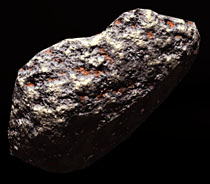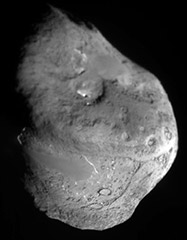

Asteroids and comets are the leftovers from the formation of our Solar System. When we think of the Solar System, we tend to think of the Sun, its eight planets, and their moons. But there is much more going on here than meets the eye. The empty spaces of our solar system are littered with small objects known as asteroids and comets. These objects can be thought of as the leftovers of the Solar System. There are chunks of rock, ice, or both that are believed to have formed from the primordial matter that originally created the Solar System. Comets have been known since ancient times. This is because they tend to announce their arrival in grand style. As the Sun heats their cores, their long, glowing tails can be seen for weeks as the circle the Sun. These objects were once thought to be omens of disaster. Several comets return like clockwork on a cycle that brings them back every few years. Comet Halley, perhaps the most famous, returns every 76 years. Unlike comets, asteroids tend to come and go unnoticed. They are usually only seen when they enter the Earth's atmosphere. A few of the asteroids in our solar system are large enough to be observed from Earth. The first to be observed was Ceres. It was discovered by a Sicilian monk named Giuseppe Piazzi in 1801. Since that time, thousands of these objects have been discovered.
Asteroids are essentially gigantic chunks of rock floating in space. They range in size from a few feet to several miles in diameter. Many asteroids orbit the Sun. Most are located in an area between the orbits of Mars and Jupiter known as the asteroid belt. There are at least 30,000 of these giant boulders in this area, each in it own individual orbit around the Sun. The asteroid belt is somewhat of a mystery. It seems there should be a planet here in this large gap instead of asteroids. Many astronomers believe that billions of years ago a large, rocky planet may have existed here. It may have been blasted apart by some type of cataclysmic event, such as a collision with a large planetoid or even another planet. Another theory states that these asteroids may have formed from the primordial material left over from the formation of the Solar System. The intense gravity of Jupiter may have prevented this material from coalescing into a planet. The asteroids in the asteroid belt range in size form just a few hundred feet to several miles. The largest, Ceres, is over 630 miles in diameter. Other asteroids have highly elliptical orbits that take them very close to the Sun. Occasionally, collisions and gravitational close encounters can push asteroids out of the asteroid belt and send them careening inward towards the Sun. Occasionally, some of these particles may come close enough to the Earth to get caught by its gravity. They may enter the atmosphere as meteors. If they survive the heat of entry and strike the ground, the will be referred to as meteorites. Scientists can study meteorites to learn more about the asteroids from which they originated.

Comets are essentially large balls of rock and ice. Many astronomers refer to them as "dirty snowballs" or "icy mudballs" because that is exactly what they look like. The ice that forms a comet can consist of both water ice and frozen gases. Astronomers believe that comets may be formed from the very material that created the early solar system. Several missions are in the works to return samples from a comet in hopes that they will help us to better understand the history of our solar system. We all think of comets as having a tail. But this tail only forms when a comet gets close to the Sun. As the comet heats up, dust and gas is expelled through cracks and fissures in its surface. This material trails behind the comet where it is illuminated by the Sun. This causes it to glow, forming the tail that comets are famous for. Comets are believed to originate from a dense shell of material surrounding the outer regions of the Solar System known as the Oort cloud. It is thought that the gravity from a passing star or other object may force some of these comets to begin moving in towards the Sun. Some have even suggested that our Sun may have an unseen companion that passes close in a highly eccentric every few hundred million years. This companion star may cause swarms of comets to head toward the inner solar system, increasing the chances of collisions. This would help to explain why our planet has experienced a cycle of mass extinctions every few hundred million years. As comets make their way along their orbits, they leave trails of material behind. If the Earth happens to pass through one of these trails, the result will be a meteor shower. There are several meteor showers every year that can be attributed to comet debris. As the particles enter the atmosphere, they leave bright streaks of hot, vaporized gas behind. These events can be quite beautiful to behold.
Asteroids and comets pose a unique problem for life here on Earth. Thousands of these objects orbit the Sun in a kind of celestial pinball game. Their paths take them dangerously close to our home planet. They are known as Earth-crossing asteroids and comets. In addition, it is believed that close encounters with stars may send additional objects from the Oort cloud careening inward towards the planets. One only has to look at our closest neighbor, the Moon, to see the result of millions of years of cosmic bombardment. Our thick atmosphere protects us from most of the smaller objects, but the big ones sometimes get through. Barringer Crater in Arizona is the result of one such incident. It is nearly a mile across and was formed by a meteor only 150 feet in diameter. Dozens of other impact craters have also been identified on our planet. They are difficult to find because erosion tends to erase them over time. Many scientists believe that the dinosaurs were killed when a asteroid or comet about 10 miles in diameter plowed into the Earth. This impact left a crater nearly 200 miles in diameter. This impact would have thrown billions of tons of rock and dust into the upper atmosphere, blocking out the sunlight. The result would have been a scenario frequently referred to as nuclear winter. The cold and lack of sunlight would have killed off all plant life. And without the plants, the animals would have died off. But that was millions of years ago. Could it happen again? Well, something exploded in the atmosphere over Tunguska, Siberia in 1908. The explosion knocked down trees like matchsticks in an area covering hundreds of miles. This explosion has been estimated to have been as strong as 1000 Hiroshima bombs. The resulting shock wave traveled around the Earth twice. Evidence that comets and asteroids still hit planets was witnessed by thousands in 1994 when come Shoemaker-Levy 9 smashed into the planet Jupiter with the force of thousands of hydrogen bombs. The impact left scars on Jupiter's surface that were larger than the Earth. It is almost certain that our planet will be struck again by one of these cosmic leftovers. But these events are extremely rare, and chances are it will be a long time in coming.
Stars | Planets | Moons | Asteroids-Comets | Nebulae | Star Clusters
Galaxies | Pulsars | Quasars | Black Holes | Dark Matter